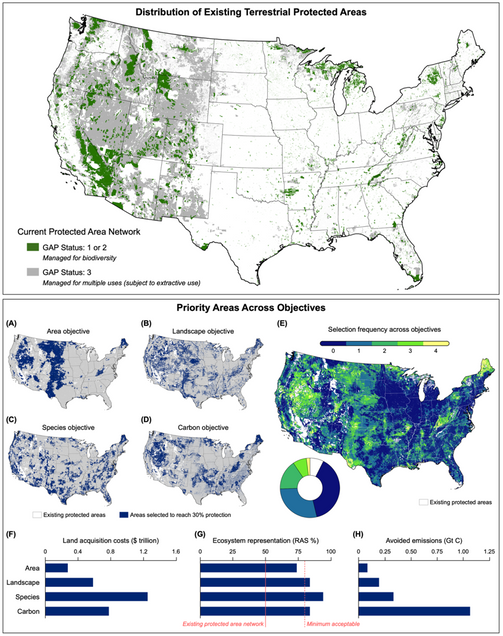Chart of the Week: Spatial Bias in US Protected Areas and the Trade-offs of Expanding Protection

In response to President Joe Biden’s recent executive order committing to protect at least 30 percent of the United States’ lands and waters by 2030 (30×30), researchers from the Global Development Policy Center, the Boston University Department of Earth and Environment, and The Nature Conservancy released a new working paper highlighting the challenges ahead for the Biden administration to deliver on this conservation target.
The current terrestrial protected area network in the United States is insufficient to curtail significant biodiversity losses. Just 7.5 percent of land in the conterminous US is protected under strict biodiversity mandates, with a large protection bias in the Southwest and Great Basin—remote areas where competition with agriculture is low. Under the executive order, coverage of the protected area estate may need to expand by more than twice its current size and filling in these ‘protection gaps’ across the US will be essential for biodiversity.
However, prioritizing areas for protection depends upon the objectives of the 30×30 target. As shown in the figure, vastly different protected area networks are generated under four different objectives reflective of the various goals within Biden’s executive order:
- An area-based objective to protect the cheapest 30 percent of land, irrespective of climate or biodiversity goals, to maximize potential for achieving the target by 2030;
- A landscape-based objective to protect the most cost-effective 30 percent of natural and production landscapes identified as climate-resilient and well-connected for biodiversity;
- A species-based objective to protect the most cost-effective 30 percent of land for current and future species distributions under climate change, inclusive of climate refugia and climate corridors to facilitate movement of species;
- A carbon-based objective to protect grasslands, shrublands, and forests at greatest risk of conversion to other land uses (5 percent of the US), as well as the cheapest remaining forested lands to secure existing carbon sinks.
Only 2 percent of the US was selected for protection under all four objectives, and roughly 28 percent was only selected under a single objective. Each objective brings different trade-offs in costs, ecosystem representation, and climate mitigation potential. This lack of congruence between objectives means the Biden administration will need to set clear biodiversity and climate objectives from the outset, including the development of appropriate performance metrics, in order to maximize dual benefits of biodiversity protection and climate mitigation. This will be critical to evaluating the success of future conservation actions amidst these important trade-offs.
Despite the challenges ahead, there is immense opportunity for the Biden administration to deliver meaningful conservation actions in the coming years. Engaging with a diversity of stakeholders, implementing more bottom-up approaches for conservation, and targeting abatable threats could propel the United States forward as a global leader in the fight for biodiversity protection and climate action.